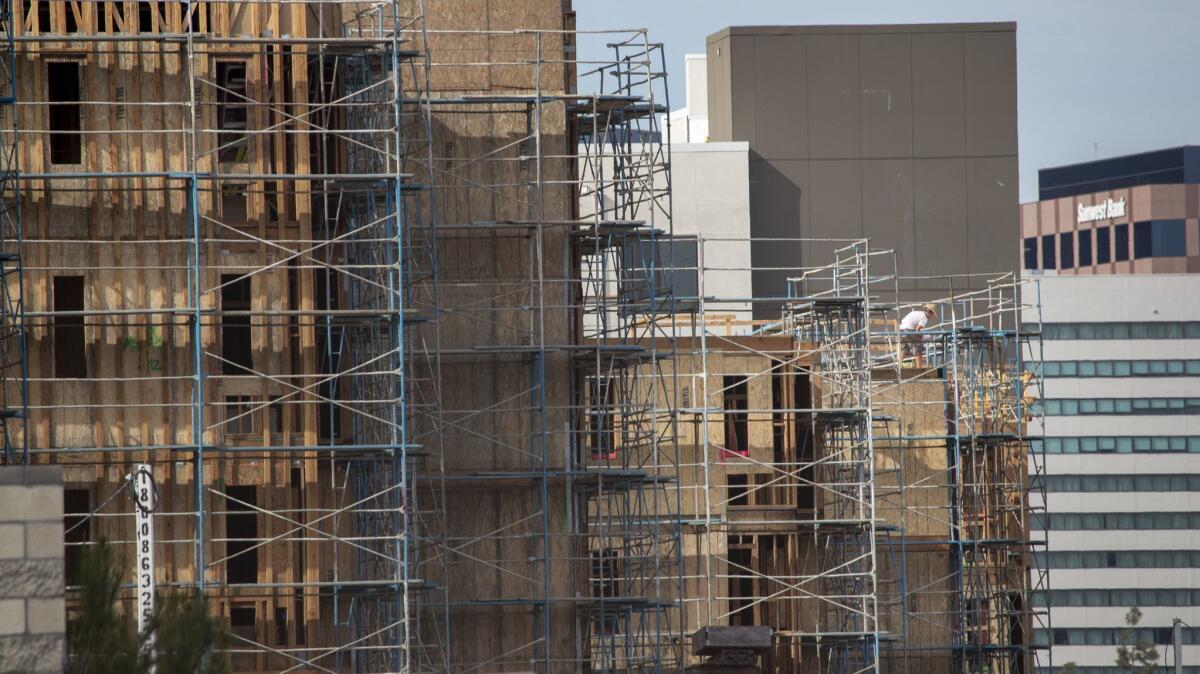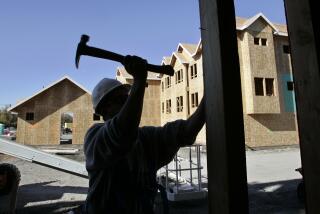Capitol Journal: Big backyards and pools are California’s past. Apartment buildings are its future

- Share via
Reporting from Sacramento — You don’t need to be a Nobel physicist to figure the direction California must go to solve its acute housing shortage — up.
Stop expanding sideways and become more like New York City — and less like us.
Those words are painful to write for a native Californian who grew up on a small orange ranch in Ojai and worships wide-open spaces. But it’s inevitable.
The California ranch-house lifestyle — founded on sunshine and ample backyard space for a pool — has become increasingly unaffordable for middle-class families in urban areas where most jobs exist. Living space has tightened and become impossibly pricey for too many.
It was wonderful when our population was only 12 million in the 1950s and 22 million in the 1970s. But now we’re at 40 million and headed to 50 million by 2050.
For many, the economics of supply and demand are making the California Dream a nightmare.
Fortunately, state legislators are awake and trying to fix it. So is Gov. Gavin Newsom. They’ve been pushing housing development away from traditional ranch-home suburbia and toward densely populated, multistory living near transportation centers. And they’re planning a lot more of that this year.
The massive Centennial project near the Tejon Pass in wildfire country is a conspicuous outlier. It was approved by Los Angeles County supervisors in December.
California prides itself on being the nation’s leader in many things, but we’re far behind the curve on creating housing easily accessible to commuter rail. The Washington, D.C., regional Metro system with its nearby apartment complexes and town houses puts California to shame.
“We set up our land-use patterns for a much smaller state,” says state Senate Housing Committee Chairman Scott Wiener (D-San Francisco). “Jobs are in major urban areas and housing has been built further and further out, forcing a lot of sprawl.
“We have people commuting by car up to 2½ hours each way, and that’s not the California Dream. Freeways have become almost impossible to use. We need more sustainable land-use patterns.”
Wiener adds: “We should put the right state standards in place so we don’t continue to gobble up farmland and open space, which is part of the California DNA. And we’re also forcing people to live in wildfire zones.
“We have a 3.5-million housing deficit and people can’t afford to live here anymore.”
Over the decades, the ranch-style home has expanded, devouring open space and pushing up prices.
“The average size ranch-style home has grown tremendously,” says Senate Transportation Committee Chairman Jim Beall (D-San Jose), a former San Jose city councilman and Santa Clara County supervisor.
“The home I grew up in [during the 1950s] was 1,300 square feet. There were eight kids. When we got to 10, we moved into a house with 1,800 square feet. Now these home-builder guys are going out in suburban areas and building 2,500- and 3,000-square-foot homes.”
Families have gotten smaller but the houses have ballooned. Why?
“You know why,” Beall replies. “Houses got bigger because they’re making more money off them. You can make more money building one big house than you can two smaller ones. And quite frankly, they’ve priced themselves out of the market for most people in California.”
Unaffordable homes and unbearable commutes are the two main factors driving housing away from suburban sprawl and toward urban transportation centers. Another motivation for Democrats is to meet their ambitious climate change goal of significantly reducing greenhouse gas emissions from tailpipes.
There are several housing bills now entering the legislative process. Some make cities and counties jittery at the prospect of losing local control to the state.
“We need to work collaboratively with the state as a partner,” says Carolyn Coleman, executive director of the League of California Cities. “We’ll get further working together than we will by some other means.”
“Other means” include Newsom suing Huntington Beach over allegedly violating state housing laws, and threatening to withhold gas tax money from cities he deems aren’t doing enough to spur home building.
One of the most controversial current bills is Wiener’s SB 50. It would attempt to boost home building near transit. Developers could build up to five-story apartment and condo complexes around rail stations. Minimum parking space requirements would be waived.
Wiener praises the cities of Los Angeles and Oakland as role models for what he’s attempting.
Sen. Nancy Skinner (D-Berkeley) has a bill that would declare a statewide housing emergency and require local governments to expedite their permitting of home building.
“The bill says, ‘Local government, do what you’re doing but do it faster,’ ” she says. “Fast-track it.”
Cut the red tape. That’s what Republicans have long advocated. Skinner’s a dedicated liberal.
Beall and Assembly housing committee chairman David Chiu (D-San Francisco) have similar bills to create new, cleaner versions of redevelopment agencies that were killed in 2011 by Gov. Jerry Brown and the Legislature. They thought the agencies were unhinged money-wasters and a bit corrupt. But the agencies spent $1 billion annually to build affordable housing. The new entities would have a tighter state leash.
Another Chiu bill would incentivize building of high-density, affordable rentals for low-income people near transit stations. It’s a proposal to keep people working and off the street.
The California ranch-house lifestyle was great in the last century. But for the poor and middle class, it’s an endangered species that needs to adapt.
Follow @LATimesSkelton on Twitter
More to Read
Get the L.A. Times Politics newsletter
Deeply reported insights into legislation, politics and policy from Sacramento, Washington and beyond. In your inbox three times per week.
You may occasionally receive promotional content from the Los Angeles Times.











